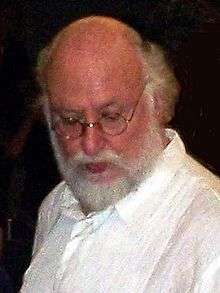Éntekhno
Éntekhno (Greek: έντεχνο, pronounced ['endexno], art song, pl: éntekhna [tragoudia]) is orchestral music with elements from Greek folk rhythm and melody. Its lyrical themes are often based on the work of famous Greek poets. Éntekhno arose in the late 1950s, drawing on rebetiko's westernization by Vassilis Tsitsanis and Manolis Chiotis. Mikis Theodorakis and Manos Hatzidakis were the most popular early composers of éntekhno song cycles.
| Music of Greece | |
|---|---|
 | |
| General topics | |
| Genres | |
| Specific forms | |
| Media and performance | |
| Music awards |
|
| Music charts | |
| Music festivals | |
| Music media |
|
| Nationalistic and patriotic songs | |
| National anthem | "Hymn to Liberty" |
| Regional music | |
| Related areas | Cyprus, Pontus, Constantinople, South Italy |
| Regional styles |
|
| Éntekhno | |
|---|---|
| Stylistic origins | |
| Cultural origins | Late 1950s, Greece |
| Derivative forms | |
Origins
As opposed to other forms of Greek urban folk music, éntekhno concerts would often take place outside a hall or a night club in the open air. Mikis Theodorakis and Manos Hadjidakis were the most popular early composers of éntekhno song cycles. They were both educated in Classical music and -among other reasons- the lacking of a wide public for this kind of music in Greece, drove them to the invention of Éntekhno, in which they transferred some values of Western art music.[1] Other significant Greek songwriters included Stavros Kouyoumtzis, Manos Loïzos, and Dimos Moutsis. Significant lyricists of this genre are Nikos Gatsos, Manos Eleftheriou and poet Tasos Livaditis. By the 1960s, innovative albums helped éntekhno become close to mainstream, and also led to its appropriation by the film industry for use in soundtracks.
Works
Notable éntekhno works include:
- Six folk paintings (Manos Hatzidakis, 1951)
- Epitaphios (Mikis Theodorakis, 1960, poetry by Yiannis Ritsos)
- Epifania (Mikis Theodorakis, 1962, poetry by Giorgos Seferis)
- Dead brother's song (Mikis Theodorakis, 1962)
- Mikres Kyklades (Mikis Theodorakis, 1963, poetry by Odysseas Elytis)
- "To Axion Esti" (Mikis Theodorakis, 1964, poetry by Odysseas Elytis)
- Gioconda's Smile (Manos Hatzidakis, 1965)
- Romiossini (Mikis Theodorakis, 1966, poetry by Yiannis Ritsos)
- Ballos (Dionysis Savvopoulos, 1970)
- O Megalos Erotikos (Manos Hatzidakis, 1972)
- Eighteen Short Songs of the Bitter Motherland (Mikis Theodorakis, 1973, poetry by Yiannis Ritsos)
- Our Great Circus (Stavros Xarchakos for the theatrical play of Iakovos Kambanellis, 1974)
- Tetralogia (Dimos Moutsis, 1975, poetry by Constantine P. Cavafy, Kostas Karyotakis, Yiannis Ritsos and Giorgos Seferis)
- Stavros tou Notou (Southern Cross) (Thanos Mikroutsikos, 1979, poetry by Nikos Kavvadias)
Artists
|
Composers:
|
Singers:
|
New Wave
A form of éntekhno which is even closer to western classical music was introduced during the mid-1960s, which was called New Wave and was a mixture of éntekhno and chansons from France. One of the first contributors to the genre was Dionysis Savvopoulos, who mixed American musicians like Bob Dylan and Frank Zappa with Macedonian folk music and politically incisive lyrics. In his wake came more folk-influenced performers like Arleta, Mariza Koch, Mihalis Violaris, Kostas Hatzis and the composer Giannis Spanos. This music scene flourished in a specific type of boîte de nuit.[2]
Contemporary éntekhno
Contemporary éntekhno is the form of éntekhno that emerged in the 1980s and is mostly what éntekhno means when used in context today.
Artists
|
|
See also
References
- "When Progress Fails, Try Greekness: From Manolis Kalomiris to Manos Hadjidakis and Mikis Theodorakis": Paris Konstantinidis, When Progress Fails, Try Greekness: From Manolis Kalomiris to Manos Hadjidakis and Mikis Theodorakis, in Nikos Maliaras (ed.), "The National Element in Music" (Conference proceedings, Athens, 18–20 January 2013), University of Athens, Athens 2014. pp. 314–320.
- Takis Kalogeropoulos: "Neo Kyma" in Lexiko tis Ellinikis mousikis, Athens 1998–99. ISBN 960-7555-39-2 (online version).
